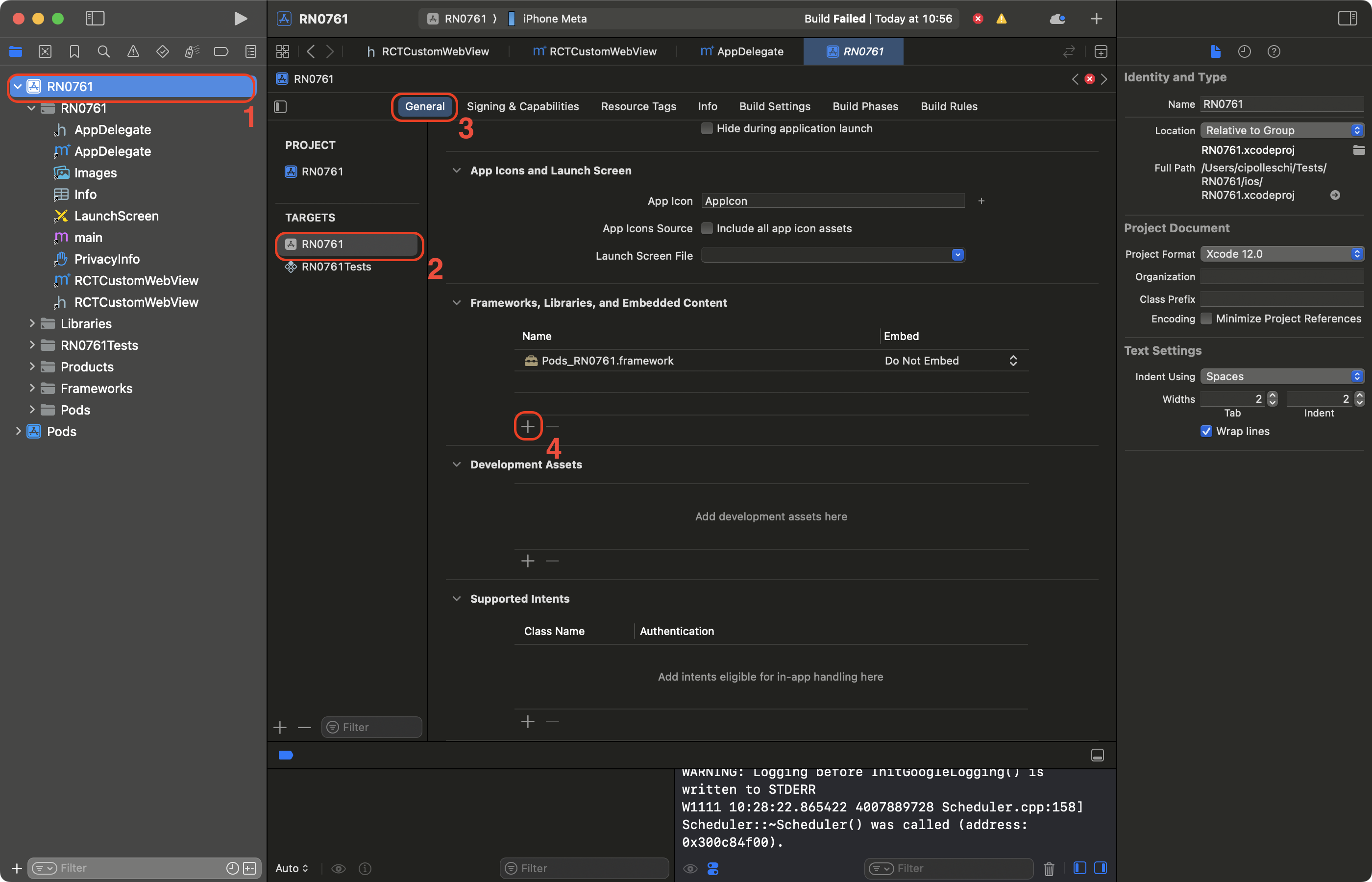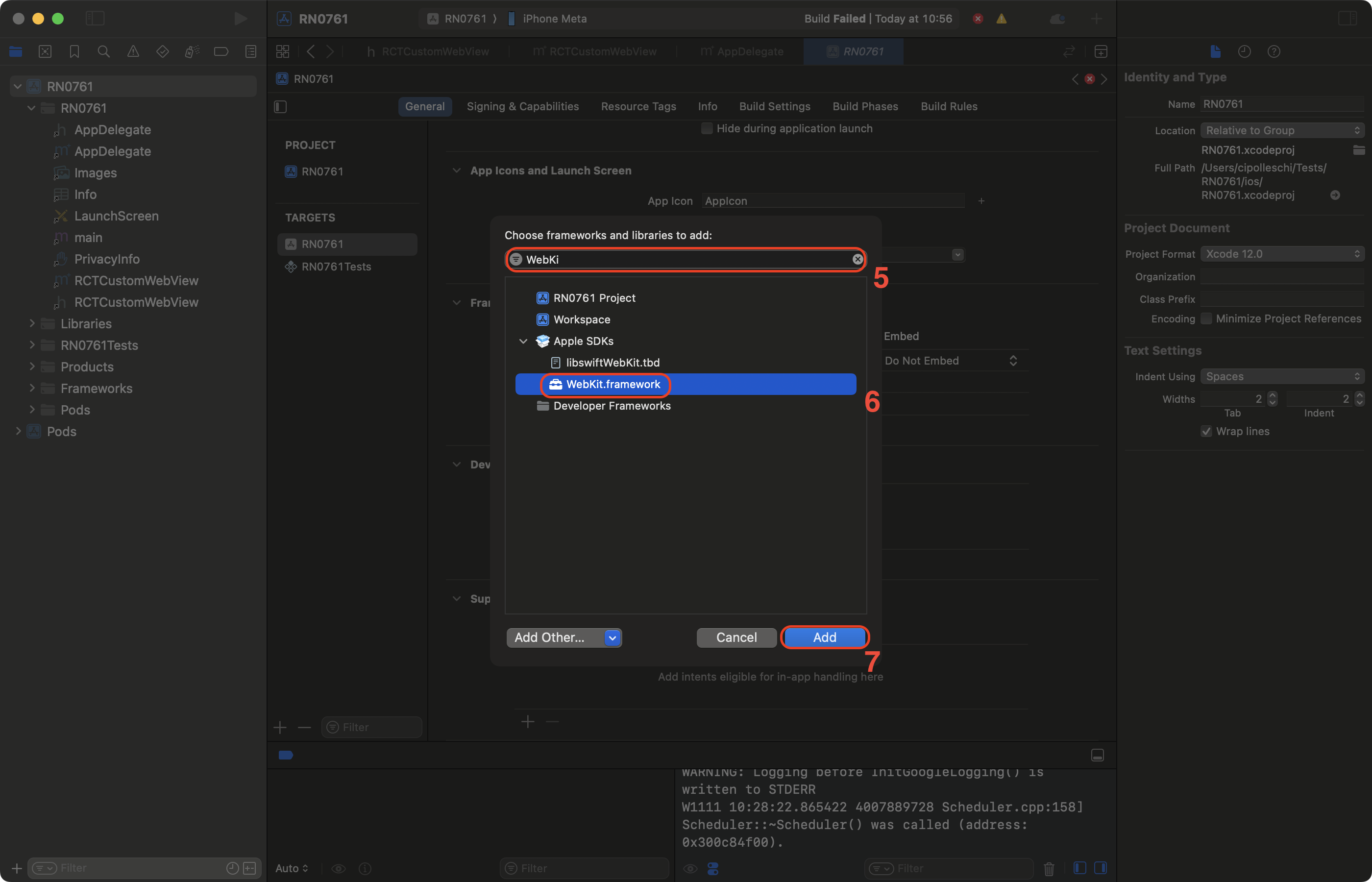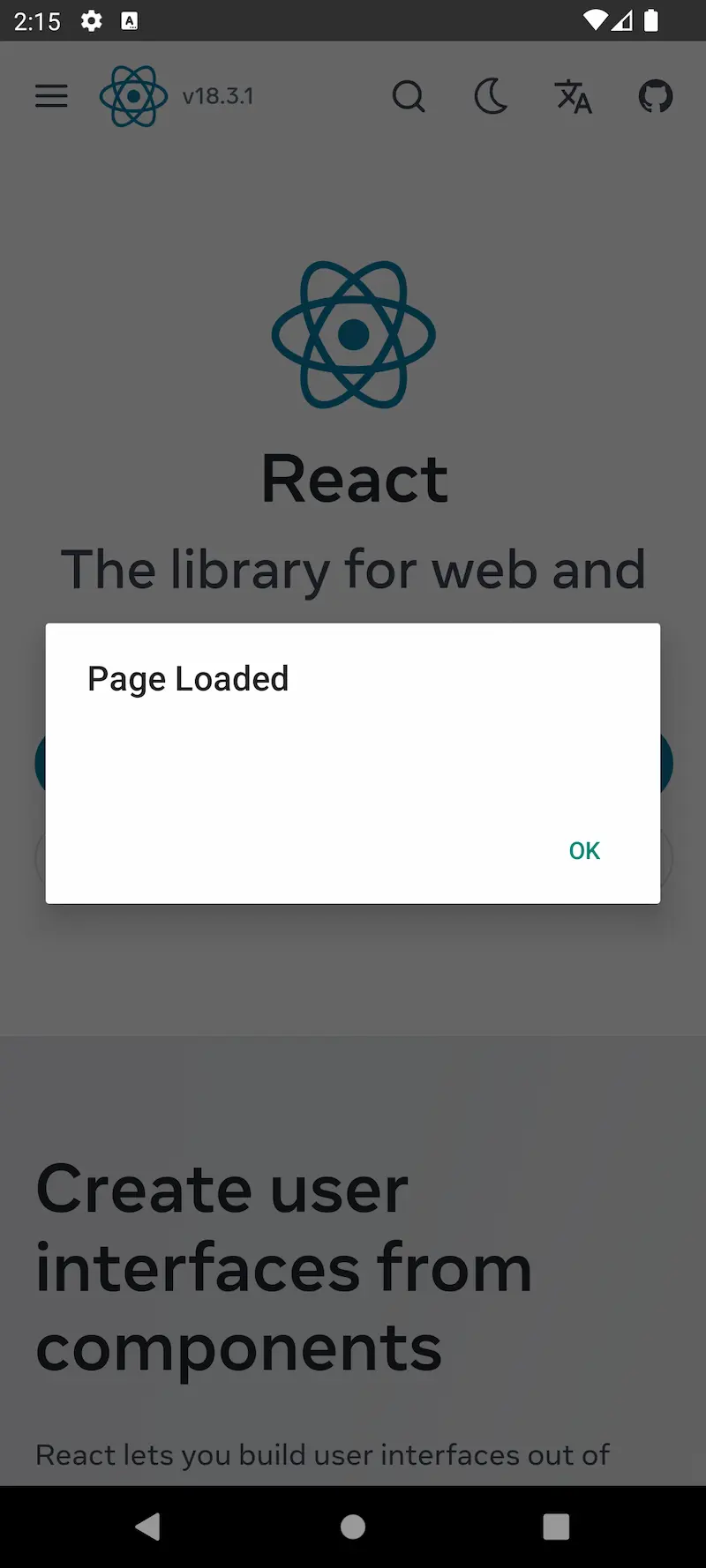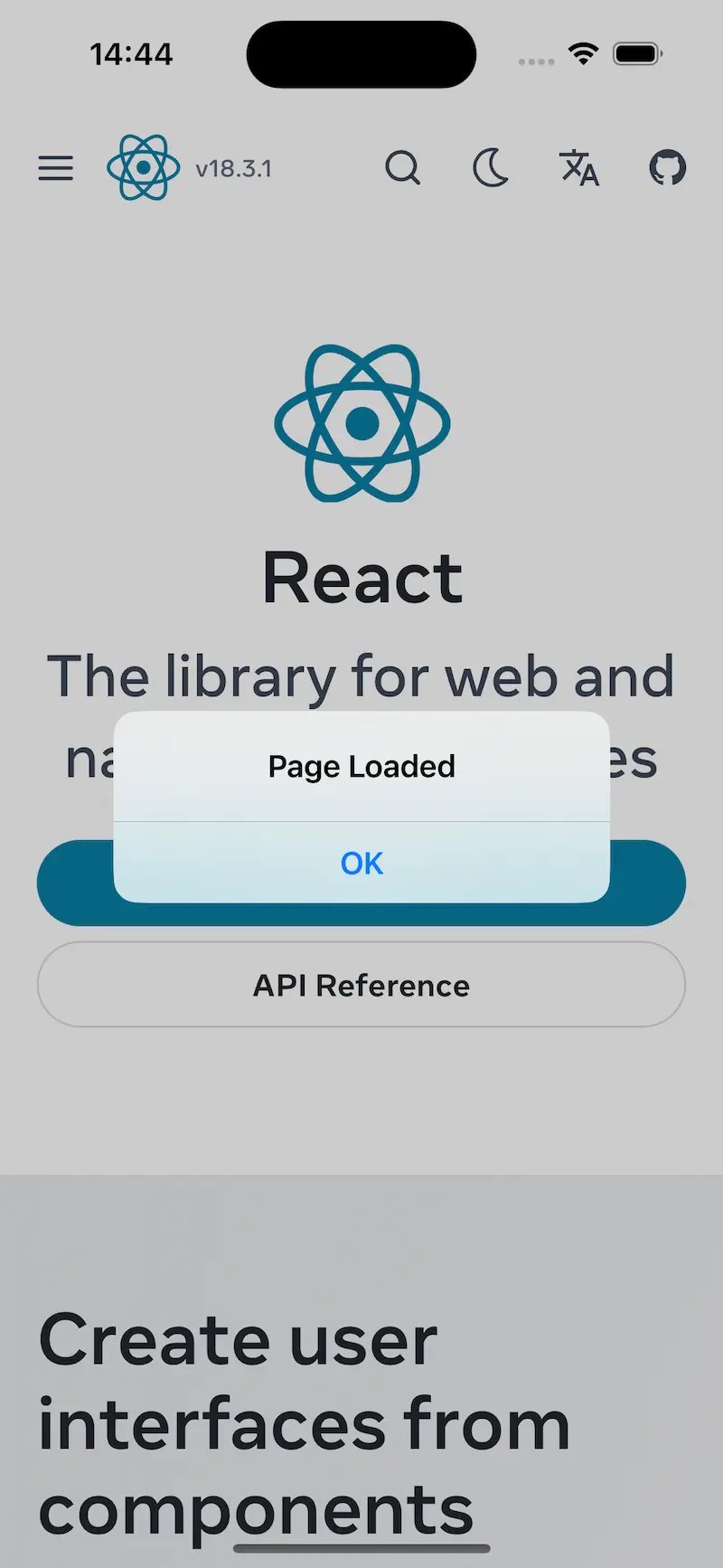原生组件
如果你想构建包装 宿主组件 的新 React Native 组件,例如 Android 上一种独特的 CheckBox 或 iOS 上的 UIButton,则应使用 Fabric 原生组件。
本指南将通过实现一个 Web 视图组件来向你展示如何构建 Fabric 原生组件。实现步骤如下:
- 使用 Flow 或 TypeScript 定义 JavaScript 规范。
- 配置依赖管理系统以从提供的规范生成代码并自动链接。
- 实现原生代码。
- 在应用程序中使用组件。
你需要一个通过普通模板生成的应用程序来使用该组件
npx @react-native-community/cli@latest init Demo --install-pods false
创建 WebView 组件
本指南将向你展示如何创建 Web 视图组件。我们将使用 Android 的 WebView 组件和 iOS 的 WKWebView 组件来创建该组件。
让我们从创建文件夹结构来保存组件代码开始
mkdir -p Demo/{specs,android/app/src/main/java/com/webview}
这将为你提供以下工作布局
Demo
├── android/app/src/main/java/com/webview
└── ios
└── specs
android/app/src/main/java/com/webview文件夹将包含我们的 Android 代码。ios文件夹将包含我们的 iOS 代码。specs文件夹将包含 Codegen 的规范文件。
1. 为 Codegen 定义规范
你的规范必须在 TypeScript 或 Flow 中定义(更多详细信息请参见 Codegen 文档)。Codegen 使用它来生成 C++、Objective-C++ 和 Java 代码,以将你的平台代码连接到 React 运行的 JavaScript 运行时。
规范文件必须命名为 <MODULE_NAME>NativeComponent.{ts|js} 才能与 Codegen 配合使用。后缀 NativeComponent 不仅是一种约定,实际上 Codegen 也使用它来检测规范文件。
为我们的 WebView 组件使用此规范
- TypeScript
- Flow
import type {
CodegenTypes,
HostComponent,
ViewProps,
} from 'react-native';
import {codegenNativeComponent} from 'react-native';
type WebViewScriptLoadedEvent = {
result: 'success' | 'error';
};
export interface NativeProps extends ViewProps {
sourceURL?: string;
onScriptLoaded?: CodegenTypes.BubblingEventHandler<WebViewScriptLoadedEvent> | null;
}
export default codegenNativeComponent<NativeProps>(
'CustomWebView',
) as HostComponent<NativeProps>;
// @flow strict-local
import type {CodegenTypes, HostComponent, ViewProps} from 'react-native';
import {codegenNativeComponent} from 'react-native';
type WebViewScriptLoadedEvent = $ReadOnly<{|
result: "success" | "error",
|}>;
type NativeProps = $ReadOnly<{|
...ViewProps,
sourceURL?: string;
onScriptLoaded?: CodegenTypes.BubblingEventHandler<WebViewScriptLoadedEvent>?;
|}>;
export default (codegenNativeComponent<NativeProps>(
'CustomWebView',
): HostComponent<NativeProps>);
此规范由三个主要部分组成,不包括导入部分
WebViewScriptLoadedEvent是事件需要从原生传递到 JavaScript 的数据的支持数据类型。NativeProps是我们可以在组件上设置的属性的定义。codegenNativeComponent语句允许我们为自定义组件生成代码,并定义用于匹配原生实现的组件名称。
与原生模块一样,你可以在 specs/ 目录中拥有多个规范文件。有关你可以使用的类型以及这些类型映射到的平台类型的更多信息,请参见附录。
2. 配置 Codegen 运行
React Native 的 Codegen 工具使用该规范为我们生成平台特定的接口和样板文件。为此,Codegen 需要知道在哪里找到我们的规范以及如何处理它。更新你的 package.json 以包含
"start": "react-native start",
"test": "jest"
},
"codegenConfig": {
"name": "AppSpec",
"type": "components",
"jsSrcsDir": "specs",
"android": {
"javaPackageName": "com.webview"
},
"ios": {
"componentProvider": {
"CustomWebView": "RCTWebView"
}
}
},
"dependencies": {
所有 Codegen 的设置都已完成,我们需要准备好原生代码来连接到我们生成的代码。
请注意,对于 iOS,我们声明性地将规范导出的 JS 组件名称(CustomWebView)与将在原生实现该组件的 iOS 类进行映射。
2. 构建你的原生代码
现在是时候编写原生平台代码了,这样当 React 需要渲染视图时,平台可以创建正确的原生视图并将其渲染到屏幕上。
你应该同时处理 Android 和 iOS 平台。
本指南向你展示如何创建仅适用于新架构的原生组件。如果你需要同时支持新架构和旧架构,请参阅我们的向后兼容性指南。
- Android
- iOS
现在是时候编写一些 Android 平台代码来渲染 web 视图了。你需要遵循的步骤是
- 运行 Codegen
- 编写
ReactWebView的代码 - 编写
ReactWebViewManager的代码 - 编写
ReactWebViewPackage的代码 - 在应用程序中注册
ReactWebViewPackage
1. 通过 Gradle 运行 Codegen
运行一次以生成你的 IDE 可以使用的样板文件。
cd android
./gradlew generateCodegenArtifactsFromSchema
Codegen 将生成你需要实现的 ViewManager 接口和 web 视图的 ViewManager 代理。
2. 编写 ReactWebView
ReactWebView 是一个组件,它封装了 React Native 在使用我们的自定义组件时将渲染的 Android 原生视图。
在 android/src/main/java/com/webview 文件夹中创建 ReactWebView.java 或 ReactWebView.kt 文件,包含以下代码
- Java
- Kotlin
package com.webview;
import android.content.Context;
import android.util.AttributeSet;
import android.webkit.WebView;
import android.webkit.WebViewClient;
import com.facebook.react.bridge.Arguments;
import com.facebook.react.bridge.WritableMap;
import com.facebook.react.bridge.ReactContext;
import com.facebook.react.uimanager.UIManagerHelper;
import com.facebook.react.uimanager.events.Event;
public class ReactWebView extends WebView {
public ReactWebView(Context context) {
super(context);
configureComponent();
}
public ReactWebView(Context context, AttributeSet attrs) {
super(context, attrs);
configureComponent();
}
public ReactWebView(Context context, AttributeSet attrs, int defStyleAttr) {
super(context, attrs, defStyleAttr);
configureComponent();
}
private void configureComponent() {
this.setLayoutParams(new LayoutParams(LayoutParams.MATCH_PARENT, LayoutParams.MATCH_PARENT));
this.setWebViewClient(new WebViewClient() {
@Override
public void onPageFinished(WebView view, String url) {
emitOnScriptLoaded(OnScriptLoadedEventResult.success);
}
});
}
public void emitOnScriptLoaded(OnScriptLoadedEventResult result) {
ReactContext reactContext = (ReactContext) context;
int surfaceId = UIManagerHelper.getSurfaceId(reactContext);
EventDispatcher eventDispatcher = UIManagerHelper.getEventDispatcherForReactTag(reactContext, getId());
WritableMap payload = Arguments.createMap();
payload.putString("result", result.name());
OnScriptLoadedEvent event = new OnScriptLoadedEvent(surfaceId, getId(), payload);
if (eventDispatcher != null) {
eventDispatcher.dispatchEvent(event);
}
}
public enum OnScriptLoadedEventResult {
success,
error
}
private class OnScriptLoadedEvent extends Event<OnScriptLoadedEvent> {
private final WritableMap payload;
OnScriptLoadedEvent(int surfaceId, int viewId, WritableMap payload) {
super(surfaceId, viewId);
this.payload = payload;
}
@Override
public String getEventName() {
return "onScriptLoaded";
}
@Override
public WritableMap getEventData() {
return payload;
}
}
}
package com.webview
import android.content.Context
import android.util.AttributeSet
import android.webkit.WebView
import android.webkit.WebViewClient
import com.facebook.react.bridge.Arguments
import com.facebook.react.bridge.WritableMap
import com.facebook.react.bridge.ReactContext
import com.facebook.react.uimanager.UIManagerHelper
import com.facebook.react.uimanager.events.Event
class ReactWebView: WebView {
constructor(context: Context) : super(context) {
configureComponent()
}
constructor(context: Context, attrs: AttributeSet?) : super(context, attrs) {
configureComponent()
}
constructor(context: Context, attrs: AttributeSet?, defStyleAttr: Int) : super(context, attrs, defStyleAttr) {
configureComponent()
}
private fun configureComponent() {
this.layoutParams = LayoutParams(LayoutParams.MATCH_PARENT, LayoutParams.MATCH_PARENT)
this.webViewClient = object : WebViewClient() {
override fun onPageFinished(view: WebView, url: String) {
emitOnScriptLoaded(OnScriptLoadedEventResult.success)
}
}
}
fun emitOnScriptLoaded(result: OnScriptLoadedEventResult) {
val reactContext = context as ReactContext
val surfaceId = UIManagerHelper.getSurfaceId(reactContext)
val eventDispatcher = UIManagerHelper.getEventDispatcherForReactTag(reactContext, id)
val payload =
Arguments.createMap().apply {
putString("result", result.name)
}
val event = OnScriptLoadedEvent(surfaceId, id, payload)
eventDispatcher?.dispatchEvent(event)
}
enum class OnScriptLoadedEventResult {
success,
error;
}
inner class OnScriptLoadedEvent(
surfaceId: Int,
viewId: Int,
private val payload: WritableMap
) : Event<OnScriptLoadedEvent>(surfaceId, viewId) {
override fun getEventName() = "onScriptLoaded"
override fun getEventData() = payload
}
}
ReactWebView 继承自 Android WebView,因此你可以轻松重用平台已定义的所有属性。
该类定义了三个 Android 构造函数,但将其实际实现推迟到私有的 configureComponent 函数。此函数负责初始化所有组件的特定属性:在此示例中,你正在设置 WebView 的布局,并且正在定义用于自定义 WebView 行为的 WebClient。在此代码中,ReactWebView 通过实现 WebClient 的 onPageFinished 方法在页面加载完成时发出事件。
然后,代码定义了一个辅助函数来实际发出事件。要发出事件,你必须
- 获取
ReactContext的引用; - 检索你正在呈现的视图的
surfaceId; - 获取与视图关联的
eventDispatcher的引用; - 使用
WritableMap对象构建事件的有效负载; - 创建需要发送到 JavaScript 的事件对象;
- 调用
eventDispatcher.dispatchEvent发送事件。
文件的最后一部分包含你需要发送事件的数据类型的定义
OnScriptLoadedEventResult,包含OnScriptLoaded事件的可能结果。- 实际的
OnScriptLoadedEvent需要继承 React Native 的Event类。
3. 编写 WebViewManager
WebViewManager 是连接 React Native 运行时与原生视图的类。
当 React 收到应用程序渲染特定组件的指令时,React 使用注册的视图管理器来创建视图并传递所有必需的属性。
这是 ReactWebViewManager 的代码。
- Java
- Kotlin
package com.webview;
import com.facebook.react.bridge.ReactApplicationContext;
import com.facebook.react.module.annotations.ReactModule;
import com.facebook.react.uimanager.SimpleViewManager;
import com.facebook.react.uimanager.ThemedReactContext;
import com.facebook.react.uimanager.ViewManagerDelegate;
import com.facebook.react.uimanager.annotations.ReactProp;
import com.facebook.react.viewmanagers.CustomWebViewManagerInterface;
import com.facebook.react.viewmanagers.CustomWebViewManagerDelegate;
import java.util.HashMap;
import java.util.Map;
@ReactModule(name = ReactWebViewManager.REACT_CLASS)
class ReactWebViewManager extends SimpleViewManager<ReactWebView> implements CustomWebViewManagerInterface<ReactWebView> {
private final CustomWebViewManagerDelegate<ReactWebView, ReactWebViewManager> delegate =
new CustomWebViewManagerDelegate<>(this);
@Override
public ViewManagerDelegate<ReactWebView> getDelegate() {
return delegate;
}
@Override
public String getName() {
return REACT_CLASS;
}
@Override
public ReactWebView createViewInstance(ThemedReactContext context) {
return new ReactWebView(context);
}
@ReactProp(name = "sourceUrl")
@Override
public void setSourceURL(ReactWebView view, String sourceURL) {
if (sourceURL == null) {
view.emitOnScriptLoaded(ReactWebView.OnScriptLoadedEventResult.error);
return;
}
view.loadUrl(sourceURL, new HashMap<>());
}
public static final String REACT_CLASS = "CustomWebView";
@Override
public Map<String, Object> getExportedCustomBubblingEventTypeConstants() {
Map<String, Object> map = new HashMap<>();
Map<String, Object> bubblingMap = new HashMap<>();
bubblingMap.put("phasedRegistrationNames", new HashMap<String, String>() {{
put("bubbled", "onScriptLoaded");
put("captured", "onScriptLoadedCapture");
}});
map.put("onScriptLoaded", bubblingMap);
return map;
}
}
package com.webview
import com.facebook.react.bridge.ReactApplicationContext;
import com.facebook.react.module.annotations.ReactModule;
import com.facebook.react.uimanager.SimpleViewManager;
import com.facebook.react.uimanager.ThemedReactContext;
import com.facebook.react.uimanager.ViewManagerDelegate;
import com.facebook.react.uimanager.annotations.ReactProp;
import com.facebook.react.viewmanagers.CustomWebViewManagerInterface;
import com.facebook.react.viewmanagers.CustomWebViewManagerDelegate;
@ReactModule(name = ReactWebViewManager.REACT_CLASS)
class ReactWebViewManager(context: ReactApplicationContext) : SimpleViewManager<ReactWebView>(), CustomWebViewManagerInterface<ReactWebView> {
private val delegate: CustomWebViewManagerDelegate<ReactWebView, ReactWebViewManager> =
CustomWebViewManagerDelegate(this)
override fun getDelegate(): ViewManagerDelegate<ReactWebView> = delegate
override fun getName(): String = REACT_CLASS
override fun createViewInstance(context: ThemedReactContext): ReactWebView = ReactWebView(context)
@ReactProp(name = "sourceUrl")
override fun setSourceURL(view: ReactWebView, sourceURL: String?) {
if (sourceURL == null) {
view.emitOnScriptLoaded(ReactWebView.OnScriptLoadedEventResult.error)
return;
}
view.loadUrl(sourceURL, emptyMap())
}
companion object {
const val REACT_CLASS = "CustomWebView"
}
override fun getExportedCustomBubblingEventTypeConstants(): Map<String, Any> =
mapOf(
"onScriptLoaded" to
mapOf(
"phasedRegistrationNames" to
mapOf(
"bubbled" to "onScriptLoaded",
"captured" to "onScriptLoadedCapture"
)))
}
ReactWebViewManager 继承自 React 的 SimpleViewManager 类,并实现了由 Codegen 生成的 CustomWebViewManagerInterface。
它持有 CustomWebViewManagerDelegate 的引用,这是 Codegen 生成的另一个元素。
然后,它重写 getName 函数,该函数必须返回与 spec 的 codegenNativeComponent 函数调用中使用的名称相同的名称。
createViewInstance 函数负责实例化一个新的 ReactWebView。
然后,ViewManager 需要定义所有 React 组件的属性将如何更新原生视图。在示例中,你需要决定如何处理 React 将在 WebView 上设置的 sourceURL 属性。
最后,如果组件可以发出事件,则需要通过重写冒泡事件的 getExportedCustomBubblingEventTypeConstants 或直接事件的 getExportedCustomDirectEventTypeConstants 来映射事件名称。
4. 编写 ReactWebViewPackage
与原生模块一样,原生组件也需要实现 ReactPackage 类。这是一个可用于在 React Native 运行时中注册组件的对象。
这是 ReactWebViewPackage 的代码
- Java
- Kotlin
package com.webview;
import com.facebook.react.BaseReactPackage;
import com.facebook.react.bridge.NativeModule;
import com.facebook.react.bridge.ReactApplicationContext;
import com.facebook.react.module.model.ReactModuleInfo;
import com.facebook.react.module.model.ReactModuleInfoProvider;
import com.facebook.react.uimanager.ViewManager;
import java.util.Collections;
import java.util.HashMap;
import java.util.List;
import java.util.Map;
public class ReactWebViewPackage extends BaseReactPackage {
@Override
public List<ViewManager<?, ?>> createViewManagers(ReactApplicationContext reactContext) {
return Collections.singletonList(new ReactWebViewManager(reactContext));
}
@Override
public NativeModule getModule(String s, ReactApplicationContext reactApplicationContext) {
if (ReactWebViewManager.REACT_CLASS.equals(s)) {
return new ReactWebViewManager(reactApplicationContext);
}
return null;
}
@Override
public ReactModuleInfoProvider getReactModuleInfoProvider() {
return new ReactModuleInfoProvider() {
@Override
public Map<String, ReactModuleInfo> getReactModuleInfos() {
Map<String, ReactModuleInfo> map = new HashMap<>();
map.put(ReactWebViewManager.REACT_CLASS, new ReactModuleInfo(
ReactWebViewManager.REACT_CLASS, // name
ReactWebViewManager.REACT_CLASS, // className
false, // canOverrideExistingModule
false, // needsEagerInit
false, // isCxxModule
true // isTurboModule
));
return map;
}
};
}
}
package com.webview
import com.facebook.react.BaseReactPackage
import com.facebook.react.bridge.NativeModule
import com.facebook.react.bridge.ReactApplicationContext
import com.facebook.react.module.model.ReactModuleInfo
import com.facebook.react.module.model.ReactModuleInfoProvider
import com.facebook.react.uimanager.ViewManager
class ReactWebViewPackage : BaseReactPackage() {
override fun createViewManagers(reactContext: ReactApplicationContext): List<ViewManager<*, *>> {
return listOf(ReactWebViewManager(reactContext))
}
override fun getModule(s: String, reactApplicationContext: ReactApplicationContext): NativeModule? {
when (s) {
ReactWebViewManager.REACT_CLASS -> ReactWebViewManager(reactApplicationContext)
}
return null
}
override fun getReactModuleInfoProvider(): ReactModuleInfoProvider = ReactModuleInfoProvider {
mapOf(ReactWebViewManager.REACT_CLASS to ReactModuleInfo(
name = ReactWebViewManager.REACT_CLASS,
className = ReactWebViewManager.REACT_CLASS,
canOverrideExistingModule = false,
needsEagerInit = false,
isCxxModule = false,
isTurboModule = true,
)
)
}
}
ReactWebViewPackage 继承自 BaseReactPackage 并实现了所有正确注册我们的组件所需的方法。
createViewManagers方法是创建管理自定义视图的ViewManager的工厂方法。getModule方法根据 React Native 需要渲染的视图返回相应的 ViewManager。getReactModuleInfoProvider提供在运行时注册模块时所需的所有信息,
5. 在应用程序中注册 ReactWebViewPackage
最后,你需要在应用程序中注册 ReactWebViewPackage。我们通过修改 MainApplication 文件,将 ReactWebViewPackage 添加到 getPackages 函数返回的包列表中来实现这一点。
package com.demo
import android.app.Application
import com.facebook.react.PackageList
import com.facebook.react.ReactApplication
import com.facebook.react.ReactHost
import com.facebook.react.ReactNativeHost
import com.facebook.react.ReactPackage
import com.facebook.react.defaults.DefaultNewArchitectureEntryPoint.load
import com.facebook.react.defaults.DefaultReactHost.getDefaultReactHost
import com.facebook.react.defaults.DefaultReactNativeHost
import com.facebook.react.soloader.OpenSourceMergedSoMapping
import com.facebook.soloader.SoLoader
import com.webview.ReactWebViewPackage
class MainApplication : Application(), ReactApplication {
override val reactNativeHost: ReactNativeHost =
object : DefaultReactNativeHost(this) {
override fun getPackages(): List<ReactPackage> =
PackageList(this).packages.apply {
add(ReactWebViewPackage())
}
override fun getJSMainModuleName(): String = "index"
override fun getUseDeveloperSupport(): Boolean = BuildConfig.DEBUG
override val isNewArchEnabled: Boolean = BuildConfig.IS_NEW_ARCHITECTURE_ENABLED
override val isHermesEnabled: Boolean = BuildConfig.IS_HERMES_ENABLED
}
override val reactHost: ReactHost
get() = getDefaultReactHost(applicationContext, reactNativeHost)
override fun onCreate() {
super.onCreate()
SoLoader.init(this, OpenSourceMergedSoMapping)
if (BuildConfig.IS_NEW_ARCHITECTURE_ENABLED) {
load()
}
}
}
现在是时候编写一些 iOS 平台代码来渲染 web 视图了。你需要遵循的步骤是
- 运行 Codegen。
- 编写
RCTWebView的代码 - 在应用程序中注册
RCTWebView
1. 运行 Codegen
你可以手动运行 Codegen,但是使用你将用来演示组件的应用程序来完成此操作会更简单。
cd ios
bundle install
bundle exec pod install
重要的是,你会看到 Codegen 的日志输出,我们将在 Xcode 中使用它来构建我们的 WebView 原生组件。
你应该小心将生成的代码提交到你的仓库。生成的代码是 React Native 每个特定版本的。使用 npm peerDependencies 来限制与 React Native 版本的兼容性。
3. 编写 RCTWebView
我们需要通过完成以下 5 个步骤来使用 Xcode 准备你的 iOS 项目
- 打开 CocoPods 生成的 Xcode Workspace
cd ios
open Demo.xcworkspace

- 右键单击应用程序并选择
New Group,将新组命名为WebView。

- 在
WebView组中,创建New→File from Template。

- 使用
Objective-C File模板,并将其命名为RCTWebView。

-
重复步骤 4 并创建一个名为
RCTWebView.h的头文件。 -
将
RCTWebView.m重命名为RCTWebView.mm,使其成为 Objective-C++ 文件。
Podfile
...
Demo
├── AppDelegate.swift
...
├── RCTWebView.h
└── RCTWebView.mm
创建头文件和实现文件后,你可以开始实现它们。
这是 RCTWebView.h 文件的代码,它声明了组件接口。
#import <React/RCTViewComponentView.h>
#import <UIKit/UIKit.h>
NS_ASSUME_NONNULL_BEGIN
@interface RCTWebView : RCTViewComponentView
// You would declare native methods you'd want to access from the view here
@end
NS_ASSUME_NONNULL_END
这个类定义了一个 RCTWebView,它继承自 RCTViewComponentView 类。这是所有原生组件的基类,由 React Native 提供。
实现文件(RCTWebView.mm)的代码如下
#import "RCTWebView.h"
#import <react/renderer/components/AppSpec/ComponentDescriptors.h>
#import <react/renderer/components/AppSpec/EventEmitters.h>
#import <react/renderer/components/AppSpec/Props.h>
#import <react/renderer/components/AppSpec/RCTComponentViewHelpers.h>
#import <WebKit/WebKit.h>
using namespace facebook::react;
@interface RCTWebView () <RCTCustomWebViewViewProtocol, WKNavigationDelegate>
@end
@implementation RCTWebView {
NSURL * _sourceURL;
WKWebView * _webView;
}
-(instancetype)init
{
if(self = [super init]) {
_webView = [WKWebView new];
_webView.navigationDelegate = self;
[self addSubview:_webView];
}
return self;
}
- (void)updateProps:(Props::Shared const &)props oldProps:(Props::Shared const &)oldProps
{
const auto &oldViewProps = *std::static_pointer_cast<CustomWebViewProps const>(_props);
const auto &newViewProps = *std::static_pointer_cast<CustomWebViewProps const>(props);
// Handle your props here
if (oldViewProps.sourceURL != newViewProps.sourceURL) {
NSString *urlString = [NSString stringWithCString:newViewProps.sourceURL.c_str() encoding:NSUTF8StringEncoding];
_sourceURL = [NSURL URLWithString:urlString];
if ([self urlIsValid:newViewProps.sourceURL]) {
[_webView loadRequest:[NSURLRequest requestWithURL:_sourceURL]];
}
}
[super updateProps:props oldProps:oldProps];
}
-(void)layoutSubviews
{
[super layoutSubviews];
_webView.frame = self.bounds;
}
#pragma mark - WKNavigationDelegate
-(void)webView:(WKWebView *)webView didFinishNavigation:(WKNavigation *)navigation
{
CustomWebViewEventEmitter::OnScriptLoaded result = CustomWebViewEventEmitter::OnScriptLoaded{CustomWebViewEventEmitter::OnScriptLoadedResult::Success};
self.eventEmitter.onScriptLoaded(result);
}
- (BOOL)urlIsValid:(std::string)propString
{
if (propString.length() > 0 && !_sourceURL) {
CustomWebViewEventEmitter::OnScriptLoaded result = CustomWebViewEventEmitter::OnScriptLoaded{CustomWebViewEventEmitter::OnScriptLoadedResult::Error};
self.eventEmitter.onScriptLoaded(result);
return NO;
}
return YES;
}
// Event emitter convenience method
- (const CustomWebViewEventEmitter &)eventEmitter
{
return static_cast<const CustomWebViewEventEmitter &>(*_eventEmitter);
}
+ (ComponentDescriptorProvider)componentDescriptorProvider
{
return concreteComponentDescriptorProvider<CustomWebViewComponentDescriptor>();
}
@end
这段代码是用 Objective-C++ 编写的,包含各种细节
@interface实现了两个协议RCTCustomWebViewViewProtocol,由 Codegen 生成;WKNavigationDelegate,由 WebKit 框架提供,用于处理 Web 视图导航事件;
- 实例化
WKWebView、将其添加到子视图并设置navigationDelegate的init方法; - 当组件属性更改时,React Native 调用的
updateProps方法; - 描述自定义视图如何布局的
layoutSubviews方法; - 允许你处理
WKWebView完成页面加载时如何操作的webView:didFinishNavigation:方法; - 检查作为属性接收的 URL 是否有效的
urlIsValid:(std::string)propString方法; - 一个用于检索强类型
eventEmitter实例的实用程序eventEmitter方法 - 返回 Codegen 生成的
ComponentDescriptor的componentDescriptorProvider;
添加 WebKit 框架
此步骤仅在创建 Web 视图时才需要。iOS 上的 Web 组件需要链接到 Apple 提供的 WebKit 框架。如果你的组件不需要访问 Web 特定的功能,则可以跳过此步骤。
Web 视图需要访问 Apple 通过 Xcode 和设备附带的框架之一提供的某些功能:WebKit。你可以在原生代码中看到它,通过 RCTWebView.mm 中添加的 #import <WebKit/WebKit.h> 行。
要在你的应用程序中链接 WebKit 框架,请按照以下步骤操作
- 在 Xcode 中,点击你的项目
- 选择应用程序目标
- 选择通用选项卡
- 向下滚动直到找到“框架、库和嵌入式内容”部分,然后按
+按钮

- 在搜索栏中,过滤 WebKit
- 选择 WebKit 框架
- 点击添加。

3. 使用你的原生组件
最后,你可以在应用程序中使用新组件。更新你的生成的 App.tsx 为
import React from 'react';
import {Alert, StyleSheet, View} from 'react-native';
import WebView from './specs/WebViewNativeComponent';
function App(): React.JSX.Element {
return (
<View style={styles.container}>
<WebView
sourceURL="https://reactjs.ac.cn/"
style={styles.webview}
onScriptLoaded={() => {
Alert.alert('Page Loaded');
}}
/>
</View>
);
}
const styles = StyleSheet.create({
container: {
flex: 1,
alignItems: 'center',
alignContent: 'center',
},
webview: {
width: '100%',
height: '100%',
},
});
export default App;
此代码创建一个使用我们创建的新 WebView 组件来加载 react.dev 网站的应用程序。
应用程序还在网页加载完成后显示一个警报。
4. 使用 WebView 组件运行你的应用程序
- Android
- iOS
yarn run android
yarn run ios
| Android | iOS |
|---|---|
 |  |